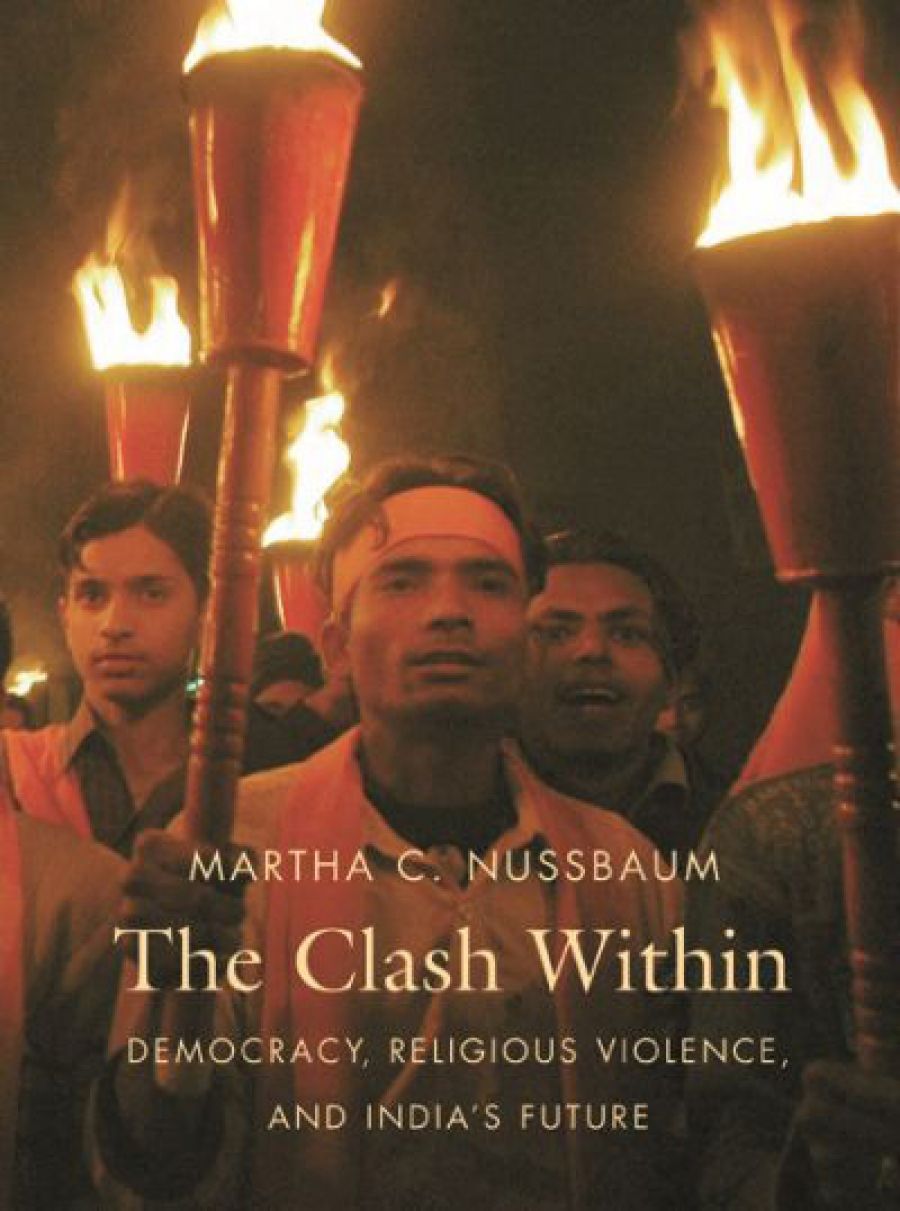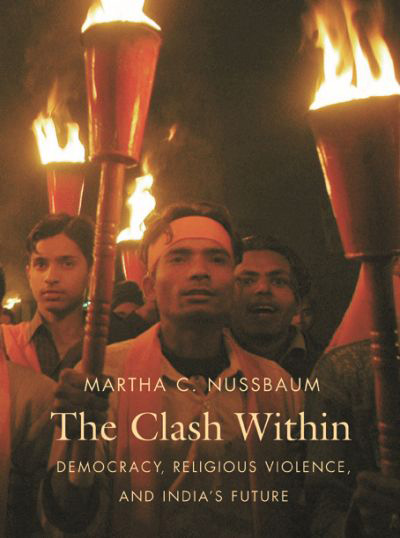
- Free Article: No
- Contents Category: Non-fiction
- Review Article: Yes
- Online Only: No
- Custom Highlight Text:
As the Ernst Freund Distinguished Service Professor of Law and Ethics at the University of Chicago, Martha Nussbaum’s confident intensity is underpinned by a dazzling range of scholarship – politics history, psychoanalysis, economics, development studies, constitutional law, archaeology, comparative religion, comparative ethnology, pedagogy, gender studies, ethics – all focused in this book on intellectually annihilating a particular minority, the Hindu religious right in India and its supporters in the United States. Nussbaum’s personal background explains her fervour. Her mother’s family descend from the Mayflower, her father was a conservative Southern lawyer, and the family lived the secure life of Philadelphia’s main line. Martha rejected these satisfactions: ‘I was ill at ease with my elite WASP heritage.’ She became involved in the civil rights movement, and converted to Judaism when she married a Jewish linguist whom she met in a class on Greek prose composition. ‘I had an intense desire to join the underdogs and to fight for justice in solidarity with them.’
- Book 1 Title: The Clash Within
- Book 1 Subtitle: Democracy, religious violence, and India's future
- Book 1 Biblio: Harvard University Press/Belknap Press, $53.95hb, 403pp
- Book 1 Cover Small (400 x 600):

- Book 1 Cover (800 x 1200):

Her latest book continues that fight in her own polymath style. The underdogs, in this case, are the Muslim minority in the west Indian state of Gujarat, the focus of a massacre which is recounted in forensic detail. On 27 February 2002 a trainload of Hindu pilgrims were returning to their homes in Gujarat after trying to construct a temple in the town of Ayodhya, on the former site of a sixteenth-century mosque. Hindus had torn it down in 1992, claiming that it had been built on the birthplace of the Hindu god Ram. When the train stopped at a station in a poor Muslim area, arguments broke out with Muslim food vendors. A crowd gathered, and stones, bottles and bricks were thrown until the train pulled out. Shortly afterwards, one of the coaches erupted into flames and fifty-eight men, women and children died. Nussbaum cites evidence that it was probably ‘a tragic accident’, an explosion of one of the cooking stove carried by the pilgrims on the train but word spread that Muslims were to blame. In the following days, more than two thousand Muslims or Hindus associated with them were slaughtered throughout the state, many burned alive as houses and shops were torched, and there were ‘mass rapes and mutilations of women’ who were then incinerated.
The police failed to intervene. The right-wing Hindu government of the state (the Bharatiya Janata Party [BJP], also at the time the national government) obfuscated and no one was ever charged. The ‘terrorists’ belonged to the State’s Hindu majority, but they themselves were a minority within the national Hindu polity. Their aim, both locally and nationally, is to ‘saffronise’ (the colour of their flag) the country by ruling with reference to ancient Hindu religious texts. One of the most inflammatory anti-Muslim leader proclaimed Gujarat ‘the graveyard of secular ideology’.
Why has Nussbaum chosen this horrendous event as her focus? Firstly, because of her long and loving relationship with India, which he views as ‘[her] second country’. She spent eight years working on development issues in collaboration with Amartya Sen, the 1998 Nobel laureate in economics. The Clash Within is dedicated to his mother, Arnita Sen, a dancer and writer, and Martha’s close friend. Nussbaum’s book Women and Human Development (2000) also focused on India, and in the past decade she has had various appointments with Indian institutions and universities, writing extensively on the country’s legal and constitutional traditions, and working with ‘academics, activists, and poor women and girls’. Significantly, her friendships link her with the scholarly traditions of Bengali culture, and ‘not so much [India’s] spiritual heritage, although I deeply respect that’. What she admires is the country’s ‘diversity, noisiness, emotionality, sheer energy, and passion for justice, together with the success of a democracy constructed out of a heritage of oppression’ (as a ‘colonial underdog’).
The threat to democracy of religious fanaticism, and the failure in this case of democratic accountability and the rule of law, are the book’s fulcrum. Nussbaum sees ‘the use of European fascist ideologies by Hindu extremists to justify the murder of innocent Muslim citizens’ as above all a lesson and warning to her own country which she calls ‘a complex and flawed society’. She considers, it seems naïvely, that the reason most Americans have ignored the Gujarati events, failing to see them as a paradigm of the serious threat to the future of democracy in the world, is because of ‘the way in which terrorism and the war on Iraq have distracted Americans from events and issues of fundamental significance’ and caused them to believe that religious extremism is ‘entirely a Muslim matter’. She urges Americans to understand ‘the resilience of pluralistic democracy’, as shown when Indians voted out the national BJP government in May 2004, and in ‘the ability of well-informed citizens to turn against religious nationalism and to rally behind the values of pluralism and equality’.
Nussbaum challenges Samuel Huntington’s ‘clash of civilizations’ thesis, positing that the clash is not civilisational, but ‘within virtually all modern nations’. She supports Mahatma Gandhi’s view that the struggle is within the individual, between ‘the urge to dominate and defile the other and a willingness to live respectfully on terms of compassion and equality’.
Naming names, she excoriates the activist right-wing Hindu diaspora in the United States for its attack on what she defends as objective scholarship by specific American academics. She also suspects that it sends fund to India’s religious extremists (although she finds it difficult to trace specific examples).
To wrestle with such a complex agenda, Nussbaum puts on one or another of her multiple hats. For those new to Indian history, she recounts the struggle against the British, centred on Gandhi, Rabandranath Tagore and Jawaharlal Nehru, and examines the Indian constitution and legal system. She plunges back to the origin myths of the ancient religious Sanscrit texts (the Vedas) to explain the right’s claims to divinely inspired Hindu supremacy, and she analyses the current Indian history wars, where textbooks have become the field of battle. Other chapters recount the rise of the Hindu right from its origins in 1925 into ‘possibly the most successful fascist movement in any contemporary democracy’, and record interviews with some of its leaders.
In the most intense chapter, ‘Fantasies of Purity and Domination’, Nussbaum delves into Freudian analysis to explain the brutality of the Gujarati attacks, particularly on women, as a reaction to a Hindu sense of self-doubt and weakness which stems from first Muslim, then British, invaders. This ‘self-feminising’ projects a fantasy of Muslim ‘manliness’ and sexual rapaciousness, and Muslim female fecundity, which must be brutally expunged. ‘[Muslims] function ... like the Jews in Germany or the Irish in England ... [as] emblems of the dark, out-of-control part of oneself from which the wounded would-be dominator needs to escape.’
Despite the immense accumulation of detail, Nussbaum’s scholarship is not always impeccable. In her defence of the humanism and educational ideals of Tagore, India’s first Nobel Prize-winner and the founder of the famous school Santiniketan, he ignores his pro-British refusal to engage with the ‘anti-colonial underdogs’ in the Quit India struggle. She compares Nehru unfavourably with Tagore for failing to incorporate a ‘religious foundation’ and a ‘public poetry’ into the structure of the Indian state, thus leaving the door open for the Hindu right’s development. Yet elsewhere she commends Nehru for employing the political model of unity for India, which ‘seems to be the only model ... that could have done justice to values of equal respect and reciprocity in that highly pluralistic nation’.
In the end, despite – or because of – its comprehensive detail, it is hard to imagine a general readership for this tour de force. Rather, The Clash Within is a challenging resource for scholars of India and those engaged in the study of terrorism and its origins. Whether it will make the impact on American thinking which the author hopes, is open to question, but anyone reading it is bound to learn something.


Comments powered by CComment